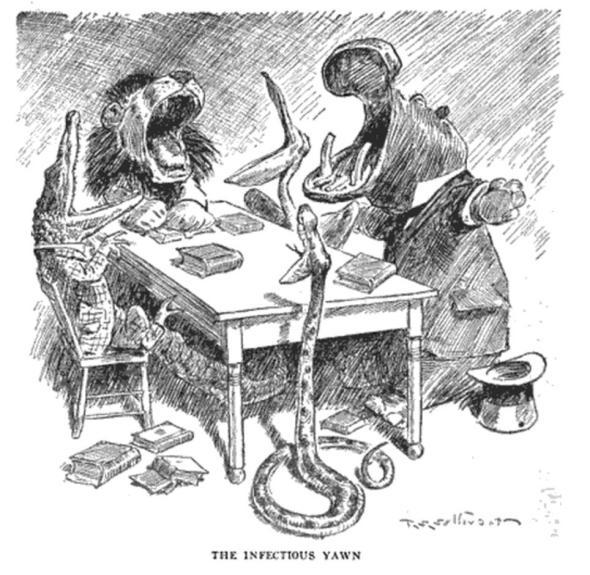It took scientists six months to train Alexandra the red-footed tortoise, but by midsummer 2009 she’d finally learned to fake a yawn. A formal experiment came right after. Once per day for several weeks, the research team placed Alexandra on one side of a small tank and another tortoise—either Moses, Aldous, Wilhemina, Quinn, Esme, or Molly—just across from her. They then signaled her to tilt back her head and drop her jaw, just as she’d been taught, while they watched the other tortoise. Would Moses drop his jaw? Would Aldous or Wilhemina? Was there any sign at all that Alexandra’s tortoise yawn could be contagious?
There was not. The research team tried again, this time having Alexandra fake her yawn not just once but twice or three times over; still, the observer tortoises did not respond. Next the scientists made Moses and the others watch a video of Alexandra in the middle of a natural yawn, not the fake one that she’d been practicing for months. Again, the yawn was not contagious.
“It is possible that a real yawn is necessary to stimulate the observer tortoise,” the authors concluded in their 2011 paper, published in Current Zoology. But “our findings are more consistent with the suggestion that tortoises do not yawn in a contagious manner.”
This finding, or lack thereof, may on its surface seem banal. But given what we know about the replication crisis in science, the tortoise paper might be a sign of things to come. Is it possible that the entire body of research on contagious yawning—a small but lively field that dates back 30 years—is resting on a shaky premise?
In the 1980s, when contagious yawning was first being studied in the lab, scientists guessed that the effect would be unique to humans. It’s not that yawns themselves were so unusual; indeed, the behavior has been observed in not just mammals but also birds, reptiles, and amphibians. Rather, the infectious yawn, the one that comes in response to someone else’s, seemed to be a special, social adaptation—a proto-form of empathy, perhaps—if not the index of a higher consciousness. “Although the analysis of yawning is in its infancy,” wrote psychologist Robert Provine, the grandfather of contagious-yawning research, in 1989, “its future looks bright.”
Provine was the first to show, back in the 1980s, that it’s more likely that a person will yawn in response to watching videotaped yawns than videotaped smiles. But the field did not take off until 2003, when Steven Platek, a researcher in Gordon Gallup’s lab at the State University of New York at Albany, offered evidence that contagious yawning might be related to “theory of mind”—one’s ability to imagine someone else’s point of view. A run of published papers after Platek’s showed that both children with autism and adults with psychopathic tendencies are less inclined than others to catch a yawn from someone else. Meanwhile, another set of studies found evidence of contagious yawning—and thus perhaps a form of social consciousness—in chimpanzees, domesticated dogs, parakeets, rats, and maybe also wolves and monkeys.
It hasn’t been that long since Provine proved that yawns can spread. But the study of contagious yawning has evolved so much since then, and spread so far into adjacent realms of neuroscience, ethology, and evolutionary psychology, that what once would have seemed totally impossible—yawn contagion in the tortoise—now merits formal testing in the lab. It even merits publication of a null result, as if we might be shocked to find that tortoise yawns don’t spread.

Slate
That’s what makes the latest study of contagious yawning, published last week, so inflammatory. In a new paper, titled “Are Yawns Really Contagious? A Critique and Quantification of Yawn Contagion,” lead author Rohan Kapitány, a postdoctoral fellow at Oxford University, argues that research on this topic suffers from a wide array of methodological problems and that these problems are so significant that they have almost certainly led to the mischaracterization of spontaneous, naturally occurring yawns as “contagious” ones. “The observation that yawning is contagious may have arisen as a consequence of our tendency to see patterns and causation where none exists, to misinterpret the clumpiness of randomness as something else,” he argues.
It’s not just tortoises. Kapitány thinks the null result—yawns don’t spread—might apply to humans, too. “It remains entirely possible that the phenomenon of contagious yawning, as observed since antiquity, is illusory,” he announces in the paper. “By using low-quality data in our theorizing … we may have been doing little more than seeing faces in clouds or reading tea-leaves.”
This is not a minor claim. If Kapitány is right, then we’d have to reckon with three decades’ worth of faulty research. It would mean that all these studies of contagious yawning, going back to Provine, have been trafficking in false-positive results, confusing mere coincidence or nonspecific mimicry for behavioral reflex, and ascribing to that nonexistent reflex a deep connection to the social mind.
Even if you ignore these studies, Kapitány’s yawns-aren’t-contagious case seems prima facie wrong. That yawns might spread from man to man is not some flashy theory concocted by psychologists in the 1980s but a widely held intuition that’s been around for millennia. “Why do men generally themselves yawn when they see others yawn?” asks the Problemata, an ancient text attributed to Aristotle. Even then, the question was phrased as if the fact of the phenomenon were self-evident. The idea spread and reappeared in Western literature and science over centuries. In the mid-1500s, Francois Rabelais described a character whose yawn was so wide-mouthed “that by mutual sympathy he set his companions yawning likewise.” Less than a century later, Francis Bacon observed that “gaping, or yawning, and stretching do pass from man and man … so that if another be apt and prepared to do the like, he followeth by the sight of another.” References abound in periodicals, in old cartoons like this one, “The Infectious Yawn,” published in Life magazine in 1914.

Google Books/Life magazine
Then again, the mere fact that a view is widely held, or that it’s been held for many generations, does not make it true. Aristotle’s Problemata, for example, follows on its question about contagious yawns with another that now seems slightly out of date: “Why do men, while standing next to fire, have the desire to pee?” it asks.
Some of our most persistent and unshakeable beliefs derive from fundamental misperceptions and distortions of our judgment. Take, for example, the belief that you can sense when you’re being watched. That’s a very common feeling—held by more than nine-tenths of the population, according to one study—and one that even has support from certain, unorthodox scientists. Yet mainstream psychologists have long understood this to be a product of confirmation bias: We tend to remember all the times we felt a tingling, turned around, and happened to notice someone staring. We forget the times we turned around and there was nothing.
So it’s possible, at least, that “contagious yawning” might have started as an apparition in the noise: a random cluster of events, perceived while standing in a crowd, that seemed to be related. The illusion might then have gotten more distinct as it was inscribed in learned works, written by Aristotle and others. When I talked to Kapitány on the phone, he suggested that what starts off as a fallacy could then sustain itself as a learned behavior—that we might yawn contagiously because we know that we’re supposed to yawn contagiously.
But what about those 30 years of scientific studies? A large and diverse research literature supports the core idea—that seeing yawns, hearing yawns, or even reading about yawns will increase the rate of yawns in laboratory subjects. What’s more, yawns appear to spread in chimpanzees, domesticated dogs, parakeets, and rats. If yawn contagion were just a product of our culture, a custom and a learned behavior, then how could we explain its contagiousness in animals?

Slate
It would have been much easier to dismiss Kapitány’s theory several years ago, before we knew about the replication crisis in psychology and other fields. We’ve now seen multiple examples of large and diverse research literatures—even those spanning several decades of work from dozens of different labs—that turn out to be infused with suspect findings. Take the theory of “ego depletion,” which says a person’s willpower functions like a finite resource, or a muscle that can be tired out. It started with a single study in the 1990s, based around a simple laboratory task involving a plate of chocolate chip cookies. From there it grew into a major field of research, spanning hundreds of experiments. Other labs customized the original research: They swapped out the cookies for jelly beans or M&M’s; they tried the test on dogs instead of people; they came up with new ideas for what it means to exercise your self-control. All these variations turned up positive results.
Then last year, a very careful attempt to reproduce the main idea of this research ended in a massive failure. But what about all those follow-up studies that supposedly confirmed that ego depletion was real? The very fact of their diversity may have made them unreliable. The original experiment had been reworked into a hundred different variations, and that gave researchers a dangerous freedom in their work. If one version of an ego-depletion study failed, they could always make adjustments and try again—and again, and again, and again—until they found something “statistically significant.” We’ve often taken this diversity of methods as a good thing, as if it helps to prove the main idea. (Wow, ego depletion doesn’t only work with chocolate-chip cookies—it works with jelly beans, too!) Yet it’s now been demonstrated that this scattershot approach can be a recipe for finding false results.
Could the same be true of contagious-yawning research? There are a few worrying similarities.
For one thing, the methods used to study yawn contagion seem to have a lot of flexibility. A 2010 review by Matthew Campbell and Frans de Waal made exactly this point: No two contagious-yawning research groups were using the same methodology. To induce contagious yawns, some teams presented people with a single yawn; others used more than 100. Some used video clips of yawning faces, others static photographs, and still others audio recordings. Experimental controls—the neutral, nonyawning conditions against which a yawning stimulus could be compared—varied widely, too. Researchers might show images of people smiling, or laughing, or making nondescript expressions. And methods of analysis were also woefully diverse, with ever-shifting definitions of which yawns should count as being “contagious.” (Would it have to occur within one minute of an observed yawn? Three minutes? Five?) And then, of course, studies looked at different species, too—not just humans but apes, birds, rats, and tortoises.
Another warning sign for ego depletion was that different studies used the same experimental logic and came to opposite conclusions. One group found that people became more charitable once their willpower had been depleted, while another found it made them more selfish. Contagious-yawning research has similar quirks and contradictions. In keeping with the proposed link with empathy, certain groups have found that women (who are more empathetic than men, on average) catch more yawns. The sex difference has even been observed in other species: She-wolves are said to catch wolf yawns more readily than he-wolves. Yet other yawning experts say there are no differences between men and women.
Meanwhile, one group found that individuals with more “psychopathic traits” are less susceptible to contagious yawning. But a closer look reveals that yawn contagion did not correlate with the overall measure of psychopathy but rather with one of three submeasures. And some of the animal findings have been downright bizarre. Domesticated dogs seem inclined to catch yawns from humans but not from other dogs. Or maybe these are not contagious yawns at all but rather evidence of dogs’ mimicry of our facial expressions? (There’s been some debate.) Rats catch yawns from other rats but only if they’re strangers. (In other species, kinship breeds contagion.) Also, rat yawns spread only when the animals are prevented from seeing one another; the contagion seems to happen through smell and sound.
There’s also the strange and disconcerting fact that contagious yawns can be fragile in the lab. Although the reflex has been described as both fundamental and ubiquitous, contagious yawns can be tricky to elicit. Research finds that contagious-yawning rates may be biased by the temperature and time of day, for example, or by subjects’ age and intelligence. (Then again, other studies refute these findings.) One study even proposed (and then disconfirmed) that a person’s politics—whether she identifies as a Republican or a Democrat—might be relevant to contagious yawning.
Most troubling, experts say contagious yawning can be extinguished altogether if you aren’t careful. The effect will go away, they say, if people feel they’re being watched. A recent study found that the mere presence of a webcam could lead people to stifle their contagious yawns. This idea goes back to Robert Provine. In 2005, he described what happened when a TV news team tried to film a version of his research. “Against my advice, the show’s producer set out to recreate my experiment in which one half of a large lecture class read an article about yawning while the other half read a control passage about hiccupping,” he wrote. This demonstration had worked beautifully for Provine in an open classroom setting—“[n]ormally the effect of the yawning article is robust,” he said—but the presence of the cameras messed it up. “As I predicted, the demonstration did not survive up-close-and-personal scrutiny by a national network television crew.”

Slate
It’s not a stretch to say that research on contagious yawning has been a bit haphazard. But Kapitány argues that the whole phenomenon might be artificial.
His new paper attempts to back up this critique of the field with two kinds of data. First, he quantified the risk of finding fake contagion by modeling the spread of yawns through a virtual crowd. Kapitány built a simulation styled on the “Game of Life” and used it to test out different assumptions for the contagiousness of yawns—that they increase observers’ baseline rate of yawning by half for a duration of three minutes, for example, or double it for five minutes. He also considered what might happen if yawns were not contagious at all—if every single yawn occurred spontaneously and was independent of any other person’s yawns. Then he let the model run and counted up how many spontaneous and contagious yawns might occur in a given two-hour stretch, based on each set of assumptions. After running dozens of these simulations, Kapitány was able to show how easily a naïve observer could mistake a spontaneous yawn for a contagious one. Under certain experimental conditions, he found the error rate would be as high as 48 percent.
Next he ran his own experiment on human subjects. Unlike every other paper in this field, Kapitány pre-registered his analysis. That means he published his plan for the experiment ahead of time, which rules out any risk of ex post facto statistical shenanigans. He had 79 undergrads come into his lab in small groups and sit around a table. The research subjects put in earbuds and spent almost an hour listening to Chopin’s “Complete Nocturnes.” For half that time, they wore blindfolds. Kapitány planned to compare the total numbers of yawns and the rates of yawning among subjects who were and weren’t blindfolded. If yawns were indeed contagious, his subjects should yawn more often when they had the blindfolds off and could see their yawning peers.
Overall, people yawned .011 times per minute with the blindfolds on and .058 times per minute—i.e., more than five times as often—with them off. For all his skepticism, Kapitány’s pre-registered experiment clearly showed that, as a group, people yawn more often when they can observe each other than when they can’t.
So the people in the study did seem to yawn contagiously, after all. But Kapitány has a different interpretation. He acknowledges that more yawns occurred in his experiment when the subjects could see each other, but he wonders if this might be the result of some learned behavior or convention rather than a contagious reflex. As evidence against the contagion theory, he pointed me to his follow-up analysis suggesting individual yawns were not correlated across individuals. People who happened to yawn during the experiment were more likely to yawn again within a few minutes. Their yawns, though, did not seem to make anyone else in the room yawn within a given window of time.
That did seem interesting, I said, but according to the paper this statistical test had not been planned ahead of time. How was I to know that Kapiáany hadn’t been massaging his data to find support for his contrarian hypothesis?
“It was the money shot of the study,” he told me, “but I forgot to register it!”
The study’s ambiguities leave us in an odd position: Kapitány’s critique of the contagious-yawning literature may be convincing on its face, but it only goes so far. Laying out ample cause for skepticism is not the same thing as debunking—and Kapitány’s own behavioral experiment doesn’t prove his case. For now, I’d be flabbergasted if his boldest claim were correct, and yawns are truly not contagious. But then, I’m also not inclined to trust the work that he’s attacking—I would be just as shocked, for instance, to learn that rat yawns really are contagious or that women really yawn more contagiously than men.
“As far as I’m concerned, there’s no debate over whether yawing is contagious in humans,” said SUNY Oneonta’s Andrew Gallup, a prolific scholar of the yawn (and the son of Gordon Gallup) who was a peer reviewer on Kapitány’s paper. He acknowledged there are some disagreements in the field, which he describes as “surprisingly contentious.” But there isn’t that much funding for the study of contagious yawns, he told me, and that fact has slowed down progress. It may be true that different labs are using different methods; it may be true that some yawns will be misclassified; it may be true that the findings of some studies will turn out to be invalid. But that’s how science works, he said. “The literature seems chaotic because we’re just beginning to work some of these things out.”
This is exactly where the replication crisis almost always leaves us—wading through a swamp of suspect data and struggling to find a patch of solid ground. We know that methods have been sloppy. We know the combination of squishy research methods and publication bias has brought us to a point where the literature on any given topic is likely to be soaked in error. It’s easy to find these flaws but hard to gauge their depth. It’s harder still to fix them.
